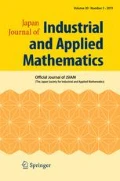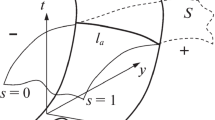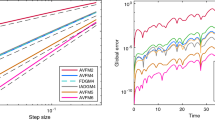Abstract
It is shown that an averaged learning equation in neurodynamics is an integrable gradient system having a Lax pair representation.
Similar content being viewed by others
References
S. Amari, Neural theory of association and concept-formation. Biol. Cybern.,26 (1977), 175–186.
S. Amari and A. Takeuchi, Mathematical theory on formation of category detecting nerve cells. Biol. Cybern.,29 (1978), 127–136.
P. Baldi and K. Hornik, Neural networks and principal component analysis: learning from examples without local minima. Neural Networks,2 (1989), 53–58.
A.M. Bloch, A completely integrable Hamiltonian system associated with line fitting in complex vector spaces. Bull. Amer. Math. Soc., (New Ser.)12 (1985), 250–254.
R.W. Brockett, Dynamical systems that sort lists, diagonalize matrices and solve linear programming problems. Linear Algebra Appl.,146 (1991), 79–91; also Proc. 27th IEEE Conf. on Decision and Control, 1988, 799–803.
P. Deift, F. Lund and E. Trubowitz, Nonlinear wave equations and constrained harmonic motion. Comm. Math. Phys.,74 (1980), 141–188.
P. Deift, T. Nanda and C. Tomei, Ordinary differential equations and the symmetric eigenvalue problem. SIAM J. Numer. Anal.,20 (1983), 1–22.
S. Geman, Some averaging and stability results for random differential equations. SIAM J. Appl. Math.,36 (1979), 86–105.
J.J. Hopfield, Neurons with graded response have collective computational properties like those of two-state neurons. Proc. Nat. Acad. Sci. USA,81 (1984), 3088–3092.
P.S. Krishnaprasad, Symplectic mechanics and rational functions. Ricerche Automat.,10 (1979), 107–135.
H. Kushner and D. Clark, Stochastic Approximation Methods for Constrained and Unconstrained Systems. Appl. Math. Sci., Vol. 26, Springer-Verlag, New York, 1978.
J. Moser, Finitely many mass points on the line under the influence of an exponential potential — An integrable system. Dynamical Systems, Theory and Applications (ed. J. Moser), Lecture Notes in Phys., Vol. 38, Springer-Verlag, New York, 1975, 467–497.
Y. Nakamura, A new approach to the linear prediction problem for infinite stationary processes in terms of Riemann-Hilbert transformation theory. IMA J. Math. Control Inform.,6 (1989), 347–358.
Y. Nakamura, Geometry of rational functions and nonlinear integrable systems. SIAM J. Math. Anal.,22 (1991), 1744–1754.
Y. Nakamura, Lax equations associated with a least squares problem and compact Lie algebras. Recent Developments in Differential Geometry (ed. K. Shiohama), Adv. Stud. Pure Math., Vol. 22, Math. Soc. Japan, Tokyo, 1993, 213–229.
Y. Nakamura, A new dynamical system that leads to eigenvalues. Japan J. Indust. Appl. Math.,9 (1992), 133–139.
Y. Nakamura, Completely integrable gradient systems on the manifolds of Gaussian and multinomial distributions. Japan J. Indust. Appl. Math.,10 (1993), 179–189.
Y. Nakamura, Gradient systems associated with probability distributions. Japan J. Indust. Appl. Math.,11 (1994), 21–30.
Y. Nakamura, Lax pair and fixed points analysis of Karmarkar’s projective scaling trajectory for linear programming. Japan J. Indust. Appl. Math.,11 (1994), 1–9.
Y. Nakamura, Developments of applied analysis based upon nonlinear integrable systems (in Japanese). Bull. Japan Soc. Indust. Appl. Math.,2 (1992), 330–342.
E. Oja, A simplified neuron model as a principal component analyzer. J. Math. Biol.,15 (1982), 267–273.
E. Oja and J. Karhunen, On stochastic approximation of the eigenvectors and eigenvalues of the expectation of a random matrix. J. Math. Anal. Appl.,106 (1985), 69–84.
J. Rubner and K. Schulten, Development of feature detectors by self-organization, A network model. Biol. Cybernet.,62 (1990). 193–199.
W.W. Symes, TheQR algorithm and scattering for the finite nonperiodic Toda lattice. Physica,4D (1982), 275–280.
M. Toda, Studies of a non-linear lattice. Phys. Rep.,8 (1975), 1–125.
C. von der Malsburg, Self-organization of orientation sensitive cells in the striate cortex. Kybernetika,14 (1973), 85–100.
Author information
Authors and Affiliations
Additional information
This research was partially supported by Grant-in-Aid for Scientific Research nos. 03804005 and 04804005 from the Japan Ministry of Education, Science, and Culture.
About this article
Cite this article
Nakamura, Y. Neurodynamics and nonlinear integrable systems of Lax type. Japan J. Indust. Appl. Math. 11, 11–20 (1994). https://doi.org/10.1007/BF03167210
Received:
Issue Date:
DOI: https://doi.org/10.1007/BF03167210




